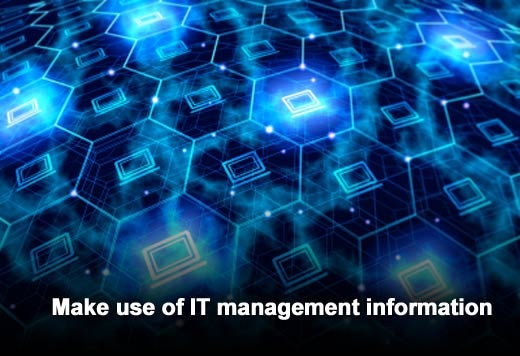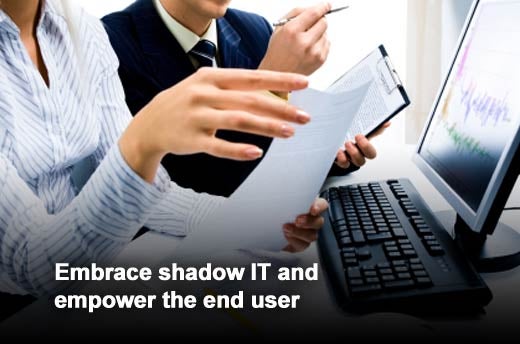Gartner predicts that by 2017, half of employers will require employees to supply their own computing device, which will create even more hurdles for IT departments as they struggle to manage an onslaught of new devices and OS systems. And if IT thinks that managing three operating systems – Android, Windows and Apple – across PCs, laptops and mobile devices is bad, just wait until the Internet of Things kicks in. Gartner estimates that by 2020, there will be up to 30 billion connected devices. To no one’s surprise, IT will be responsible for ensuring all these connected devices do not disrupt the workplace and/or place valuable corporate data at risk.
How can IT keep up with massive transformation occurring in the workplace besides running for the hills? For one, it can face the fact that control and responsibilities have shifted and they need to change their perspective about enabling the end user and therefore enabling IT. LANDESK Software‘s CMO Steve Morton explains in this slideshow how IT departments can transform from a “Department of No” to the “IT-topia of Yes.”

Click through for eight ways IT can transform from a department of ‘no’ to a business enabler, as identified by LANDESK Software’s CMO Steve Morton.

Become a business enabler.
Recognize that the business of IT is changing. It’s not about resetting passwords anymore, although that’s certainly a part of it. The new ideal IT department is predictable, repeatable and invisible. IT can increase its strategic position by helping their company take the next step forward in productivity and profitability. McDonald’s saw that they could save time if customers filled their own drinks. Let’s provide our end users with their own cups. It really is common sense. By enabling and empowering end users, IT can focus less on the repetitive minutia and more on projects that drive business growth.

Give up trying to control everything around the end user.
No matter how hard IT pros try, they will not be able to control the end user anymore. That horse left the barn when personal mobile devices entered the network. Especially as more and more millennials enter the workforce, end users are becoming increasingly tech savvy and increasingly less likely to ask permission before they do something to their computer (or phone, or tablet). If IT serves as a roadblock, users will find a way around. However, what they can control are those things that are essential to the business – corporate data, intellectual property, and access to resources.

Track your IT assets (and not with a spreadsheet).
Right now, there are more than 12,000 IT vendors selling thousands of products to organizations. IT departments are literally buried in products and many of these products aren’t even being used. The amount of money being spent by organizations to update and license these unused products is colossal. IT departments are often being asked to do more with less and cutting out unnecessary product support is a key area where budget can easily be found.

Unplug Groundhog Day.
Users spend a lot of time asking the same questions. Depending on which survey you believe, anywhere between 30 to 70 percent of service desk calls are simple password resets, which can be easily automated, along with many other service desk requests. Empower end users to fix these simpler problems themselves, freeing IT to focus on more strategic tasks.

Make your people security smart.
Users are an organization’s greatest liability for a security breach. Human error accounts for more than one-third of all data breaches, according to the Ponemon Institute’s 2013 “Cost of a Data Breach Report.” If you aren’t training your users on security best practices, there isn’t a data protection solution out there that can protect your environment from being compromised.

Make use of IT management information.
Look for ways to improve operations through the analysis of the information provided by your management software. Are there types of devices that are being used more frequently? Are people requesting and using software that is competitive with the officially sanctioned company choices? Why is this the case and does it make sense to consider making changes? What trends can you uncover that have the potential for informing decisions and improving operations?

Embrace shadow IT and empower the end user.
This may be hard to swallow. In fact, every IT pro’s instincts probably scream against it. But end users are going to embrace rogue purchasing, BYOD and other user-driven productivity initiatives with or without IT support. By embracing and encouraging that, IT can simultaneously provide tools that keep end users’ rogue habits within IT’s observational scope. Embracing shadow IT means shifting more of the responsibility to the user by providing tools, such as a self-service catalog, that allow end users to go find what they need to be productive, within a scope that IT can control.

Recognize different priorities and work to find a compromise.
End users – despite what their actions may indicate – are not out to get IT. Similarly, IT – despite their actions – are not out to trip up end users and make their lives more difficult. End users just want to get their job done well and quickly. It’s all about productivity. IT just wants to keep corporate data where it belongs and ensure they have a complete picture of IT assets and the network in order to maintain both. It’s all about security and control. By starting at a recognition of these essential differences, IT and end users can work together to enable each other.

















